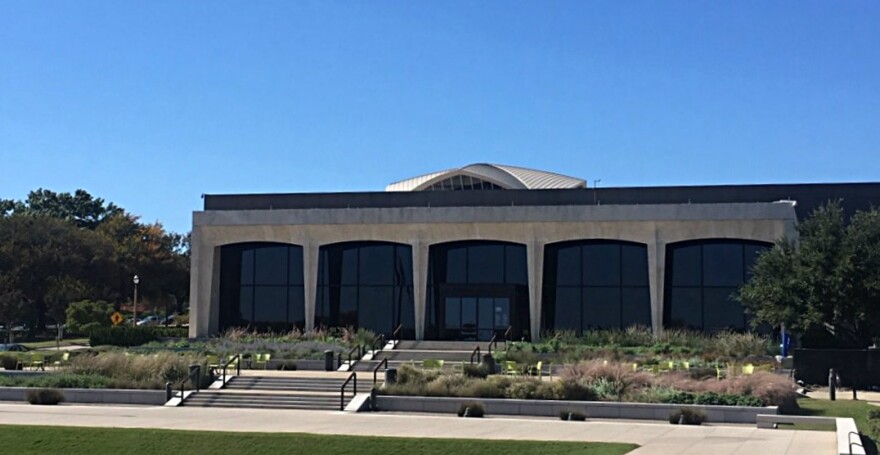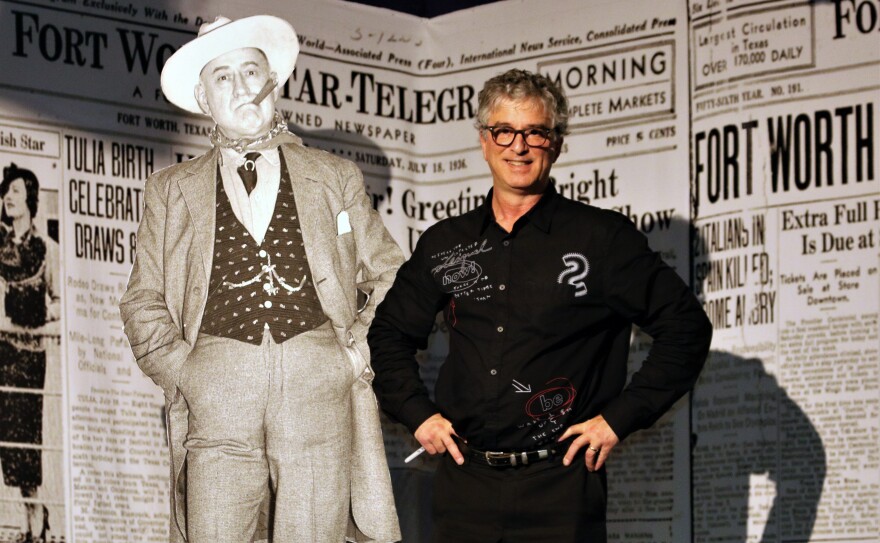For many North Texans — particularly the thousands of newcomers who've moved here -- Amon G. Carter is just a name on a museum, a college stadium (at TCU), several streets, even a lake. But Carter was an epic figure in the city's history. And Dave Leiber, the "Watchdog" columnist for the Dallas Morning News was inspired to write a one-man play about him, a play that opens this weekend in Hurst.
So — who was Amon G. Carter? And why's his name all over Fort Worth?
"Amon Carter was a cultural phenomenon that you don't find anymore in the United States," Lieber said. "He ran Fort Worth for 50 years. He ran the city. He ran West Texas. He was the dominant figure in this region for half a century."
And how did he do all that?
"He was the owner of the Fort Worth Star Telegram, which went out in a dozen editions across the state, the largest paper in the state at the time. They dropped it out of an airplane, they had so many subscibers. Then he started WBAP a hundred years ago, the second station in the Southwest after WRR in Dallas. And then in 1948, he launched Channel 5 (NBC 5). So he had complete domination of the media: radio, TV and newspaper."
Even so, the newspaper didn't make Carter much money. He only became truly rich because of oil. But he wasn't just another Texas oil man. Carter became this larger-than-life figure — both beloved and berated. He was an unstoppable civic booster for all things Fort Worth. He didn't just love the city, he completely identified with it. Nothing was too good for his town.
"He was very competitive," Lieber said, "and he was a marketing genius. And so he wanted the biggest and the best of everything. One example is what he did to Dallas in 1936. He ran his own Centennial fair in competition with the city of Dallas's official fair. And, you know, there was nudity, there was gambling and all kinds of wicked things going on at the Fort Worth Fair. And it attracted many, many people. And it was all because of competition."
Actually, San Antonio was considered the logical, deserving place to mark the state's 100 years, considering that neither Dallas nor Fort Worth were around in 1836. But Dallas won the bidding war for the state's official exposition. In Fort Worth, a modest Frontier Days had been planned until Carter got involved.
For the now-renamed Fort Worth Frontier Exposition, Carter hired Broadway impresario Billy Rose, who brought in such acts as Jumbo, the elephant, and the scandalous 'fan dancer' Sally Rand. There were huge neon signs advertising "Wild! and "Whoopee." He even built the original home of Casa Manana.
In the video above Amon Carter himself appears in a March of Time newsreel. He's doing what he loved, cheerleading for Fort Worth, and taking a dig at all those smug dudes in Dallas:
"You'd think Dallas invented Texas, just because they bid higher for the centennial than any other city. But we're going to put on a show of our own and teach those dudes over there where the West really begins!"

In fact, "Fort Worth is where the West begins, and Dallas is . . . where the East peters out" was a favorite, oft-quoted line of Carter's.
That kind of drive — not just a competitiveness but the compulsion to beat everyone else, to have nothing but the best — it's a little like a child wanting to have all the attention, isn't it?
"Yeah," Lieber said, "his stepmother kicked him out of the house when he was 13, and he had to live as an adult in his teenage years by himself."
Lieber added: "You know, he also was married three times. And his third wife was 25 years younger than him. And you just did not do two divorces and then marry someone 25 years younger than you, back in his heyday. But he had so much power nobody was going to say anything to him."
For people outside of Texas, Carter became a popular embodiment, an iconic image of Texas. But he wasn't some laconic, dusty rancher checking on his herd. Carter had all this energy and money. He was entertaining. He was a boisterous friend of Franklin Roosevelt and the humorist Will Rogers.

But then, he also made national news because he had a drinking problem — and a firing-his-revolver problem. At the 1928 Houston Democratic Convention, he impatiently shot up a hotel elevator for being too slow.
"Yeah, he dressed up like a cowboy for public appearances," Lieber said. "And he'd put on these purple TCU boots, and he actually hated wearing boots. And he had this diamond tie pin and he'd wear his cowboy hat that he used to give away by the hundreds. And he just pretended to be a cowboy."
It should be said that in drumming up business for Fort Worth, steering lots of federal money there, helping what became Lockheed get started — Carter was a preeminent civic salesman but also a shrewd businessman, looking after his own interests. Helping Fort Worth helped him. If nothing else, such efforts brought his newspaper more readers.
"But what I like about him most," Lieber said, "was he used his power to bring improvements to West Texas. If it wasn't for him, there wouldn't have been a Texas Tech. There might not have been a Big Bend National Park. Those are big legacies that he left us with."
To that list, one might add the Amon Carter Museum of American Art. Although his daughter, Ruth Carter Stevenson, was one of the driving forces behind the museum's creation, it began with her father's will. It included a legacy to build a non-profit, public museum to house his extensive collection of paintings and bronze sculptures by Frederic Remington and Charles M. Russell — and "to aid in the promotion of cultural spirit in the city of Fort Worth and vicinity, to stimulate the artistic imagination among young people residing there."

Lieber's one-man bio-drama, called simply Amon: The Ultimate Texan, stars Kelvin Dilks as Carter. Since its premiere in 2019, it's played in six towns in Texas, including Abilene. And the Hurst production is the start of what Lieber hopes will be a tour.
AMON! is actually a rather affectionate portrait of the man. And that feels different for the journalist — certainly different from his popular Watchdog columns in the Morning News. There, he's a Javert-like figure, a relentless investigator and consumer advocate. He's scornful of businesses and elected officials. He holds them accountable for scamming people, ignoring voters, burdening customers with lousy service.
So writing such a play must have been a break from all that.
"Exactly," Lieber said. "I had to create an escape from the world of fraud in business and government. I had to go back into the past and revel in the '30s and the '40s and the '50s. And it's a way for me to keep my sanity because I've been doing the Watchdog column for 17 years. And it hurts sometimes, to write about and meet people who've been hurt by others. So this was an escape for me — really."
This conversation was edited for brevity and clarity.
AMON! The Ultimate Texan opens Aug. 27 at the Artisan Center Theatre in Hurst and runs through Sept. 10.
Got a tip? Email Jerome Weeks at jweeks@kera.org. You can follow him on Twitter @dazeandweex.
Art&Seek is made possible through the generosity of our members. If you find this reporting valuable, consider making a tax-deductible gift today. Thank you.




